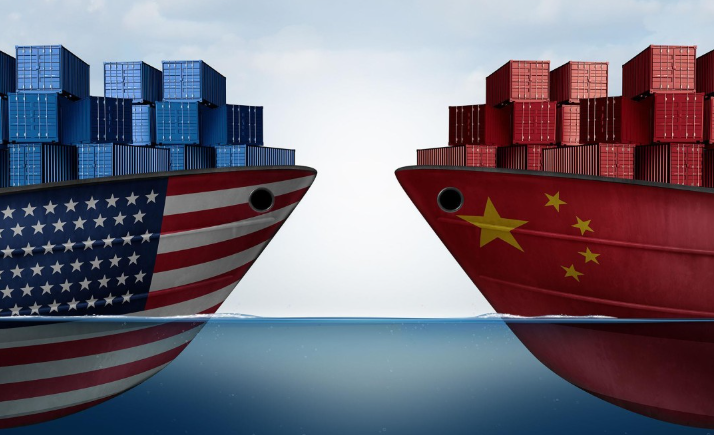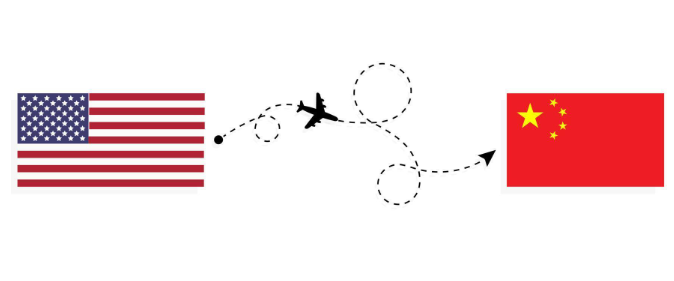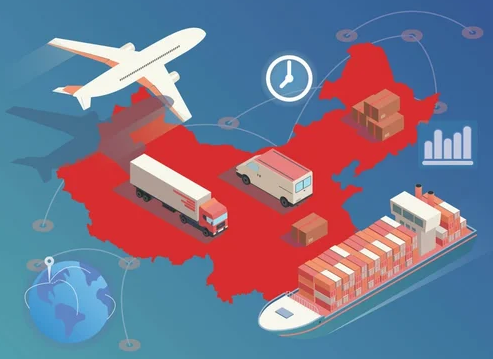Be your Logistics Department in China
Customized logistics solutions, your logistics expert in China
Customized logistics solutions, Shipping from China to the World
Tel:+8613424475220 Email:info@viputrans.com 
China and the US are constantly racing for the title of the biggest economy in the world. It is not surprising that despite the rivalry, both China and the US are suitable trading partners.
In the complex and dynamic world of international trade, effective logistics play a crucial role in ensuring that products move efficiently from one part of the world to another. The trade between the United States and China has grown significantly over the years, and with it, the demand for reliable, cost-effective, and fast transportation services. This article will provide an overview of the key modes of transport, the main products imported into mainland China, and the process of re-exporting goods from Hong Kong to Russia.
When transporting goods from the United States to China, businesses have several logistics options, each with its own advantages. These methods typically depend on the nature of the cargo, the time frame, and the cost considerations.
Sea freight is the most common mode of transportation for large volumes of goods traveling from the United States to China. This is especially true for non-perishable goods, bulky items, and machinery.
Major ports in the U.S. that export to China include:
Los Angeles and Long Beach, California: The largest and busiest port complex in the U.S. handles a significant portion of imports and exports to China.
Seattle, Washington: A key port in the Pacific Northwest, serving both China and Hong Kong.
Oakland, California: Known for its proximity to Silicon Valley and handling high-tech exports.
New York/New Jersey: Serves as an East Coast gateway to China.
Common routes for sea freight from the U.S. to China include:
Los Angeles to Shanghai or Shenzhen: One of the busiest and most frequent routes for ocean freight.
Seattle to Hong Kong or Shanghai: Primarily used for electronics, machinery, and consumer goods.
Oakland to Hong Kong or Guangzhou: Typically used for high-tech and e-commerce products.
Main cargo ports in China
Shanghai
Shenzhen
Ningbo-Zhoushan
Guangzhou
Qingdao
Transit Time: Sea freight from the U.S. to China generally takes between 50 days, depending on the origin port and destination in China.
When it comes to container shipping, there are two options:
FCL and LCL. FCL (Full Container Load) means that only one person uses the whole container.
LCL (Less Container Load) means that one container is shared by many importers/exporters.

For time-sensitive shipments, air freight offers a much faster option, especially for high-value or perishable goods. The main international airports in the U.S. offering direct services to China include:
Los Angeles International Airport (LAX) to Shanghai Pudong (PVG)
New York’s John F. Kennedy International Airport (JFK) to Beijing Capital (PEK)
Chicago O’Hare International Airport (ORD) to Hong Kong International Airport (HKG)
Transit Time: Air freight shipments typically take around 12 to 24 hours to reach China, with customs clearance adding a day or two depending on the destination.
Major cargo airports in China
Shanghai Pudong International Airport (PVG)
Beijing Capital International Airport (PEK)
Guangzhou Baiyun International Airport (CAN)
Shenzhen Bao'an International Airport (SZX)
Hong Kong International Airport (HKG)

Mainland China is one of the world’s largest and most diverse import markets. The country imports a wide range of products from the United States, with the following categories representing the majority of imports:
China imports a significant quantity of advanced electronics and electrical components, including:
Semiconductors and integrated circuits
Consumer electronics (smartphones, computers, and household appliances)
Electrical machinery and equipment
The automotive industry in China is booming, and as such, the country imports a large amount of automotive parts and finished vehicles, including:
Auto parts (engines, transmissions, electronic components)
Electric vehicles and hybrid vehicles
Luxury cars and trucks
China is one of the largest consumers of agricultural products, and the U.S. is a key supplier of the following:
Soybeans
Meat (beef, pork, and poultry)
Dairy products (milk powder, cheese)
Fresh fruit (apples, grapes)
China imports significant quantities of pharmaceuticals, vaccines, and advanced medical equipment to meet its growing healthcare needs, including:
Medical devices (surgical instruments, diagnostic equipment)
Biopharmaceuticals
Vaccines and health supplements

Hong Kong is often used as a hub for re-exporting goods to other parts of Asia, including Russia. Due to its strategic location, robust infrastructure, and business-friendly environment, many companies use Hong Kong as an intermediary for re-exporting goods, especially for items with high demand in Russia.
Consumer Electronics: Smartphones, laptops, and home appliances are in high demand in Russia, particularly from brands unavailable locally.
Fashion and Apparel: International brands, including clothing, accessories, and luxury goods, are highly sought after in the Russian market.
Cosmetics and Beauty Products: Global beauty products, especially those from the U.S. and Europe, are popular among Russian consumers.
Automotive Parts and Accessories: Due to the Russian market's preference for imported vehicles and spare parts, this category has strong re-export potential.
Food and Beverages: Premium food products, including snacks, beverages, and packaged foods from the U.S., are highly desirable.
Customs Clearance in Hong Kong:
Ensure that all goods comply with Hong Kong’s export regulations. Goods are typically free to move out of Hong Kong with minimal barriers, but import documentation and certification may be needed depending on the product.
Documentation and Tariffs:
Prepare the necessary paperwork, including a commercial invoice, packing list, bill of lading, and any required certificates of origin or compliance.
Be aware of any tariffs or restrictions that may apply to goods re-exported from Hong Kong to Russia. While Hong Kong is a duty-free port, tariffs may apply when the goods enter Russia.
Shipping Arrangement:
Depending on the nature of the product, select the appropriate mode of transport (air, sea, or rail). Sea freight is usually cost-effective for bulk items, while air freight is faster for high-value, time-sensitive products.
Customs Clearance in Russia:
Upon arrival in Russia, goods must go through Russian customs clearance. Ensure that all required customs duties, VAT, and other taxes are paid, and that any necessary inspections are conducted.
Distribution and Delivery:
Once cleared, goods can be delivered to distributors, retailers, or end consumers in Russia. Using local warehouses and logistics partners can streamline the process and reduce delivery times.
By utilizing these transport services and understanding the products that move between the U.S. and China, as well as the role of Hong Kong as a re-export hub, businesses can ensure efficient, timely, and cost-effective logistics for their operations. Whether importing to China or re-exporting to Russia, leveraging these logistics networks is crucial to staying competitive in the fast-paced world of international trade.
Shawn.Liao(Mr.) Phone/Wechat/Whatsapp/Skype: +8618926970495E-MAIL.:sales04@viputrans.com;
If you are interested in shipping from the United States to China, please feel free to contact us.
Copyright © 2003-2025 VIPU Supply Chain Logistics Co., Ltd. | All Rights Reserved
LOGISTICS | E-COMMERCIAL FULFILLMENT | ABOUT US | CASE | NEWS | VIDEO | CONTACT US
We will find the fastest or the cheapest way for your shipment. Please specify: where from, where to, what to ship.